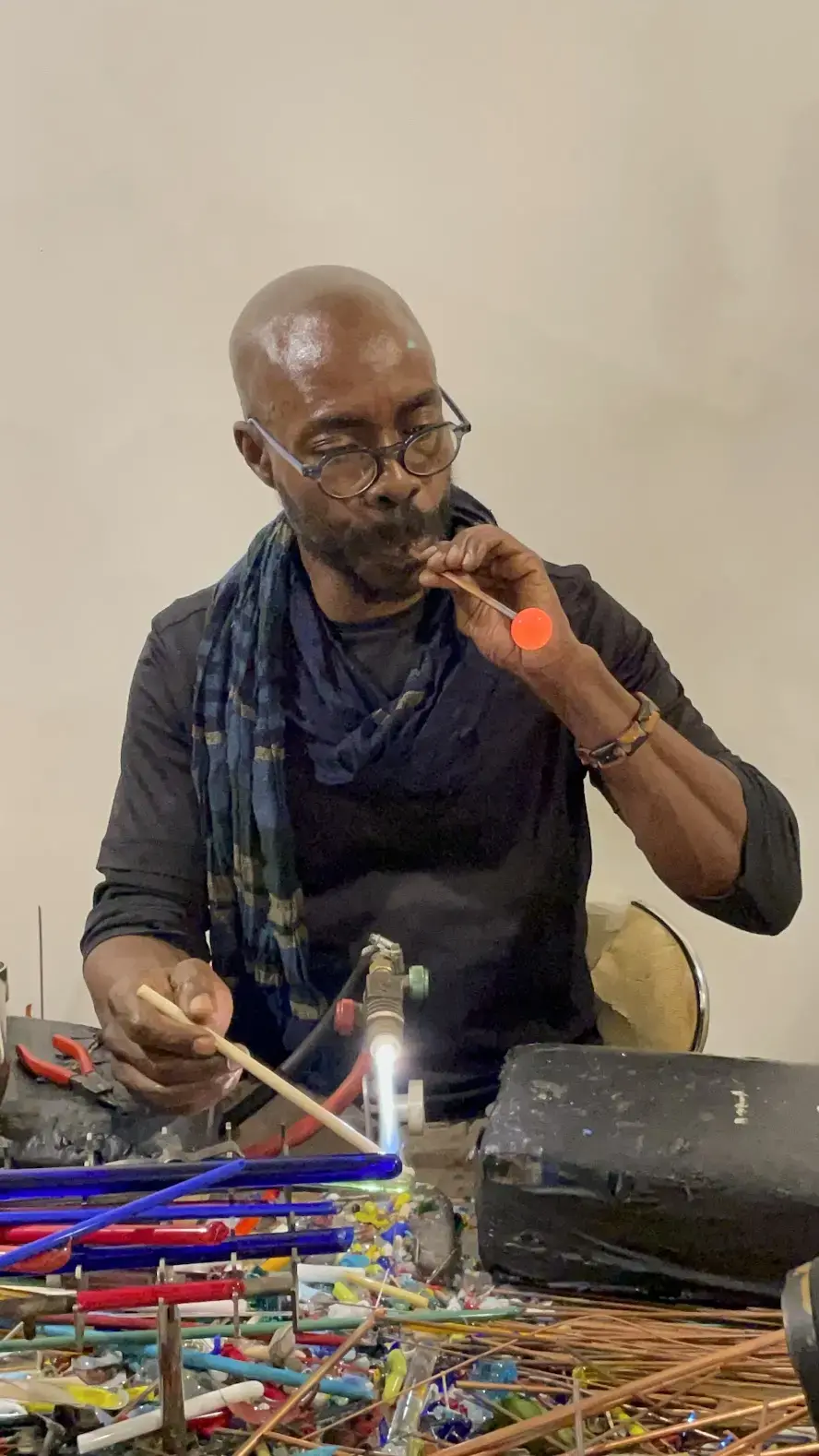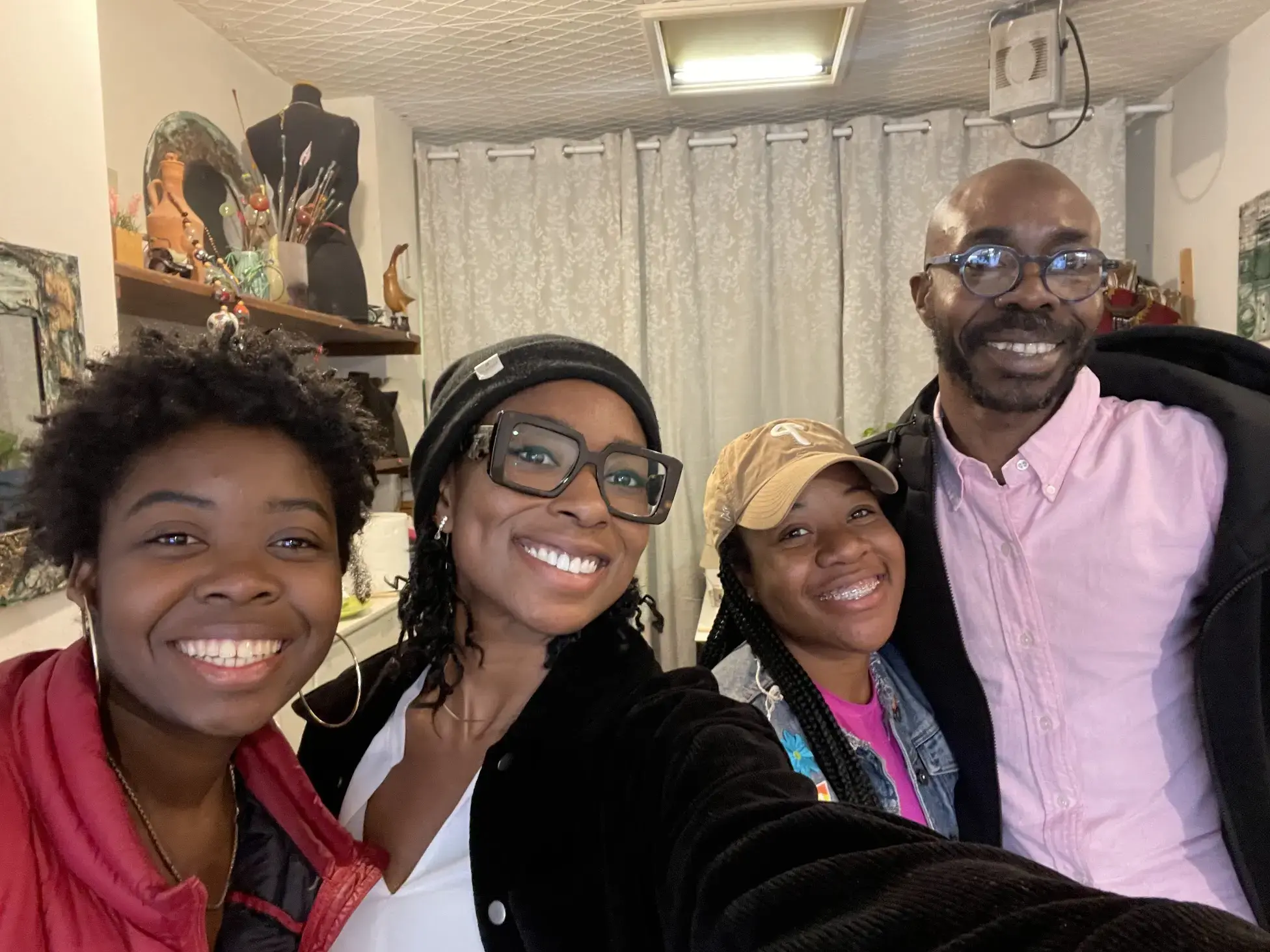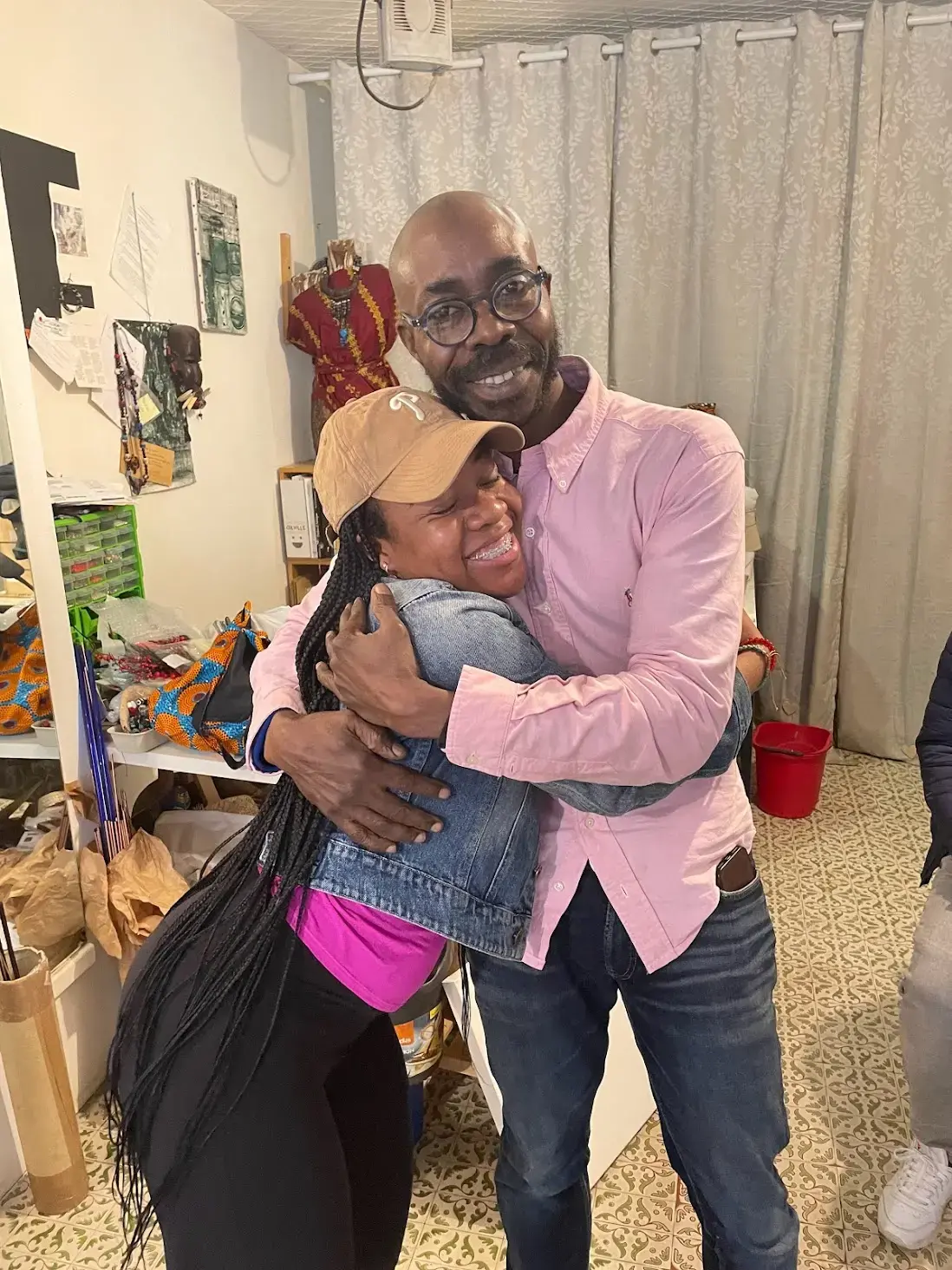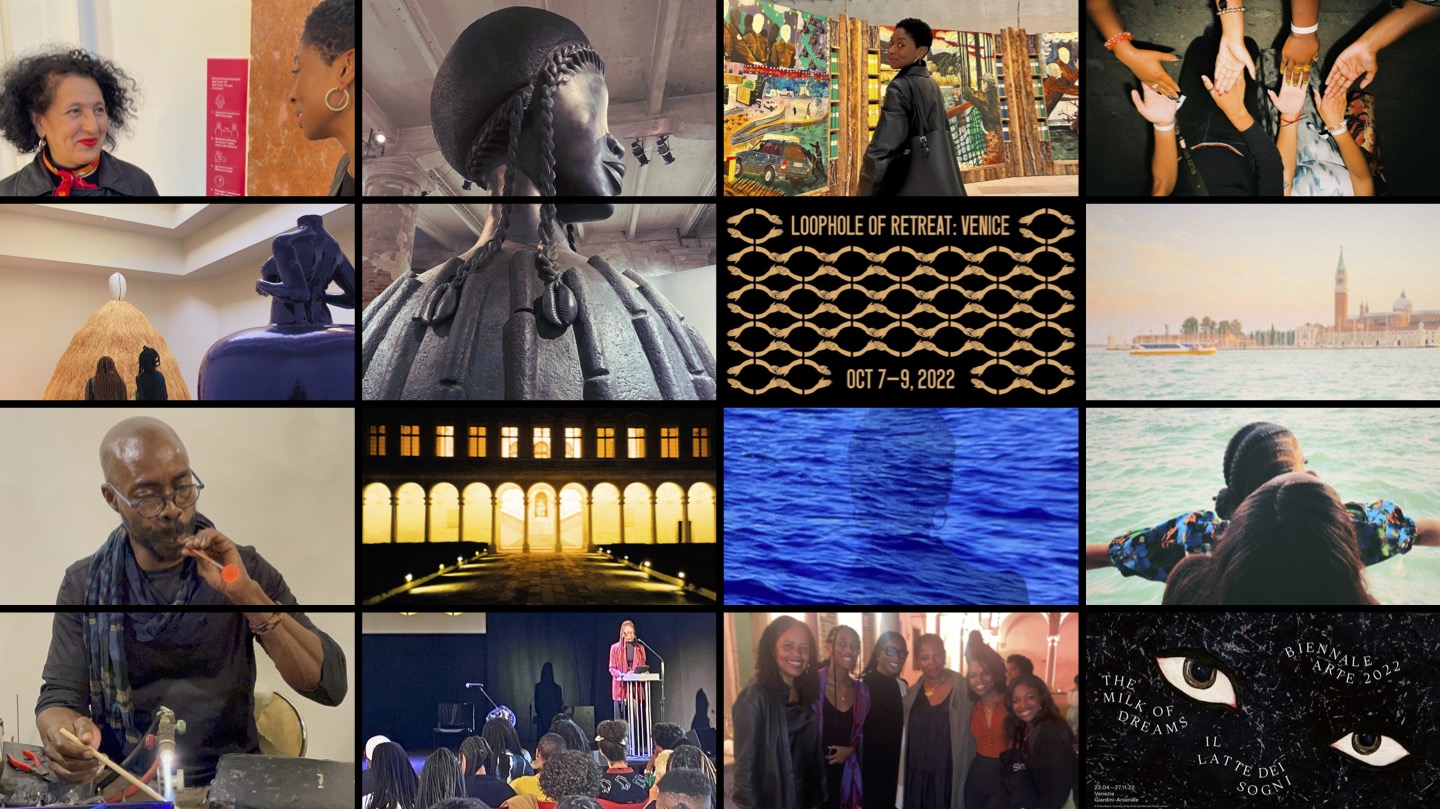A conversation with glass artist Moulaye Niang leads to a conversation about an overlooked component of the Transatlantic slave trade and reflections on how to dismantle Eurocentricity in the arts.

Much of my appreciation for Venice came from walking around the island and exploring with no particular destination in mind. On my second day, I stumbled upon a glass atelier that caught my eye more than the nearly two dozen others I had passed: a Black man was sitting dapper in the shop as he blew through a thin metal cylinder to expand the circumference of a quasi-liquid, quasi-solid, soon-to-be-glass bead.
Lured by his mesmerizing process, the beautiful creations in the display cases, and the text above the doorway that read “Arte Africana in Verro,” I entered the shop. “Buongiono,” the artist said with a warm intonation. He looked up from his work to meet my gaze as I stood awestruck, watching him heat the bead of amorphous glass and turn it a brilliant shade of sunset orange.
We switched to conversing in French after Moulaye Niang shared with me that he is originally from Senegal. He opened his storefront, Collection Muranero, in 2006 after training extensively at Scuola Abate Zanetti, the only official institute for learning Murano glass art.*
After discussing his roots and artistic inspirations, I told Moulaye that I would be moving to Dakar to explore the flourishing contemporary art scene in Senegal and investigate the trend of Black Americans expatriating to West Africa, many of whom are searching for a homegoing and sense of belonging as their ancestors are descendants of the region. His face lit up, and he began sharing his thoughts with me, all while continuing to form beads and blow bulbs; it was as if his tools were an extension of his body that moved with him seamlessly.
“Many people, Black Americans included, don’t know the full story of the Transatlantic slave trade,” he began. “Most people don’t know about the lançados.”
As if I was in a living room receiving worldly truths from a wise friend, Moulaye shared about a fascinating yet little-known component of migration and human relations during this time in history that forever shifted the trajectory of the Anthropocene.
The lançados (pronounced lan-sah-dose) were Portuguese settlers who voyaged to Senegambia (now Senegal and the Gambia), Cape Verde, Sierra Leone, and other areas on the coast of West Africa to escape religious persecution during the Portuguese Inquisition, as many of them were Jewish.* Upon arrival in West Africa, they kidnapped wives from local African ruling families, sexually exploited them, and used these women as collateral to secure protection and advantageous trading ties with West African communities. This practice took place throughout the 16th, 17th, and 18th centuries.
Then the lesson took a deeper turn. Moulaye explained that mixed-race children conceived by the lançados and captured African women were brought to Europe, including Italy, where they were raised and educated to believe Africans were inherently inferior and needed European leadership. Then they were sent back to West Africa, installed throughout the region, and operated as proxy rulers for Europeans. The lançados and their descendants were crucial intermediaries between Europeans and West Africans. They wielded significant power in the early development of port economies in Bissau, Cacheu, and surrounding areas.
As Moulaye spoke, I began thinking about the character Malik in the film The Woman King, a half-West African and half-European slave trader. Moulaye’s lesson began to sound very familiar when I remembered that Malik was one of the main facilitators of buying and selling West Africans when the crew arrived. There were also overt elements of domination and coercion in his relationship with Nawi, a young Dahomean warrior: Malik critiqued her traditional Agojie uniform and gave her his undergarments to wear instead. He also convinced her to break stringent Agojie rules to visit him.
I wondered if the writers initially wanted the film’s references to the lançados’ role in slavery, colonization, and exploitation to be more overt but Hollywood’s status quo of sanitization and dilution when it comes to depicting the Transatlantic slave trade prohibited that venture. Or perhaps what I was picking up on was not intended at all. Either way, I realized in my moment of reflection that The Woman King is the only recount of the Transatlantic slave trade that I have been made privy to that includes even the potential of an interrogation of the lançados’ role, and I would not have picked up on it without Moulaye’s lesson.
On the other hand, the complex history of African communities trading members of defeated tribes to Europeans without being made aware of what would happen to the captives at their next destination is often skewed in recounts of the Transatlantic slave trade to make African communities seem more villainous and culpable. At the end of his recount, Moulaye posited: “If it’s true that West Africans conspired and helped to as great of an extent that the history books describe, why don’t West African countries have better standing with Europeans? Why don’t they have the same or similar infrastructure and richness as Europeans… it doesn’t add up. If West Africans and Europeans had participated in the same crime, they should have benefited similarly, but this is not the case.”
These are complex queries requiring deep analysis and literature review. Moulaye’s advice and a sentiment that I echo is that we all have to do our own research to uncover the truth and not take spoon-fed, sanitized histories as our only point of departure. “We also have to think critically,” he said. “It is not true that brothers were selling brothers as some recounts of the slave trade say.”
Moulaye and I remain in touch. When I returned to Venice in the spring of 2023, I brought friends to his shop. They, too, were wonderstruck by his craftsmanship, kindness, and wisdom. These friends, Paris and Halima, were also surprised and happy that he was an African-descended artist maintaining a successful career in Venice. This is not something they expected to see after spending the afternoon on the island of Murano, where everyone occupying art spaces, artists, vendors, and gallerists, were of white European descent.
The brilliance of sub-Saharan African artists, migrant artists, and other groups who have been marginalized from the mainstream art ecosystem is gravely devalued and underappreciated. So too are the atrocities that the European West committed throughout sub-Saharan Africa. Moulaye’s identity as the first non-Venetian glass artist to be named “master” by the Muranese and Venetian old-guard* and a Senegalese man who takes inspiration for his creations from the flora and architecture of Gorée Island* models the connection between the two minimizations.
Dismantling Eurocentricity in the arts requires action and intention. To conclude this piece but keep the door of this conversation open and the flow of knowledge ongoing, I offer four summarized excavations from my conversations with Moulaye.
It is of the utmost importance to:
- Explore and study the work of African-descended artists with rigor and respect.
- Make deep connections in artistic communities, especially those of marginalized communities, by listening to seasoned practitioners.
- Seek the full truth and history of European colonization by examining biases, critiquing faulty representations, and noticing how the tendrils of neocolonialism continue to unfurl.
- Support African-descended artists unabashedly by introducing them and their work to your friends and family and purchasing their work.
You can read more about Moulaye, purchase his creations, and learn more about his practice by clicking here.


Author's Notes:
*Murano glass is special because it is an art form that has existed on Murano island in Venice, Italy, for over a thousand years and is handmade only by highly skilled artisans within a somewhat insular community.
*From 1536 to 1821, the Portuguese Inquisition, led by the Catholic Church, investigated those accused of religious infidelity. The Inquisition tried more than 50,000 people and executed around 2,000. The most serious crimes included Judaism, Lutheranism, Islam, heretical opinions, witchcraft, and bigamy. “Lançados” translates to “the thrown-out or cast-out ones” in Portuguese.
*Glass art has been traced back as far as the first century BCE in Egypt and Assyria.
*Gorée Island was a major entrepôt of the Transatlantic slave trade. Ruled in succession by the Portuguese, Dutch, English, and French from the 15th to the 19th century, its architecture is characterized by the contrast between the grim quarters where captured Africans were detained and the elegant houses of the slave traders. Today it continues to serve as a reminder of human exploitation and as a sanctuary for reconciliation.






